mark.c File Reference
Marking primitives. More...
#include "internal.h"
Go to the source code of this file.
Defines | |
| #define | gi (&tm.node_color_iter[tm_GREY]) |
Functions | |
| __inline void | _tm_range_scan (const void *b, const void *e) |
| void | _tm_root_loop_init () |
| Initialize root scanning loop. | |
| static void | _tm_root_scan_id (int i) |
| Scan a root id. | |
| void | _tm_register_scan () |
| Scan registers. | |
| void | _tm_set_stack_ptr (void *stackvar) |
| Set the stack pointer. | |
| void | _tm_stack_scan () |
| Scan stack (and registers). | |
| void | _tm_root_scan_all () |
| Scan all roots. | |
| int | _tm_root_scan_some () |
| Scan some roots. | |
| void | tm_mark (void *ptr) |
| Marks a possible pointer. | |
| void | _tm_node_scan (tm_node *n) |
| size_t | _tm_node_scan_some (size_t amount) |
| Scan node interiors for some pointers. | |
| void | _tm_node_scan_all () |
| Scan until all tm_GREY nodes are tm_BLACK. | |
Variables | |
| long | tm_root_scan_some_size = 512 |
| Amount of roots words to scan per tm_malloc(). | |
Detailed Description
Marking primitives.
Definition in file mark.c.
Define Documentation
| #define gi (&tm.node_color_iter[tm_GREY]) |
Referenced by _tm_node_scan_some().
Function Documentation
| __inline void _tm_range_scan | ( | const void * | b, | |
| const void * | e | |||
| ) |
Definition at line 15 of file mark.c.
References _tm_mark_possible_ptr(), tm_data::n, tm_msg(), and tm_PTR_ALIGN.
Referenced by _tm_node_scan(), and _tm_root_scan_id().
00016 { 00017 const char *p; 00018 00019 /* Avoid overlapping pointer. */ 00020 e = ((char *) e) - sizeof(void*); 00021 00022 for ( p = b; 00023 (char*) p <= (char*) e; 00024 p += tm_PTR_ALIGN ) { 00025 #if 0 00026 tm_node *n = 00027 #endif 00028 _tm_mark_possible_ptr(* (void**) p); 00029 00030 #if 0 00031 if ( n ) { 00032 tm_msg("M n%p p%p\n", n, p); 00033 } 00034 #endif 00035 } 00036 }
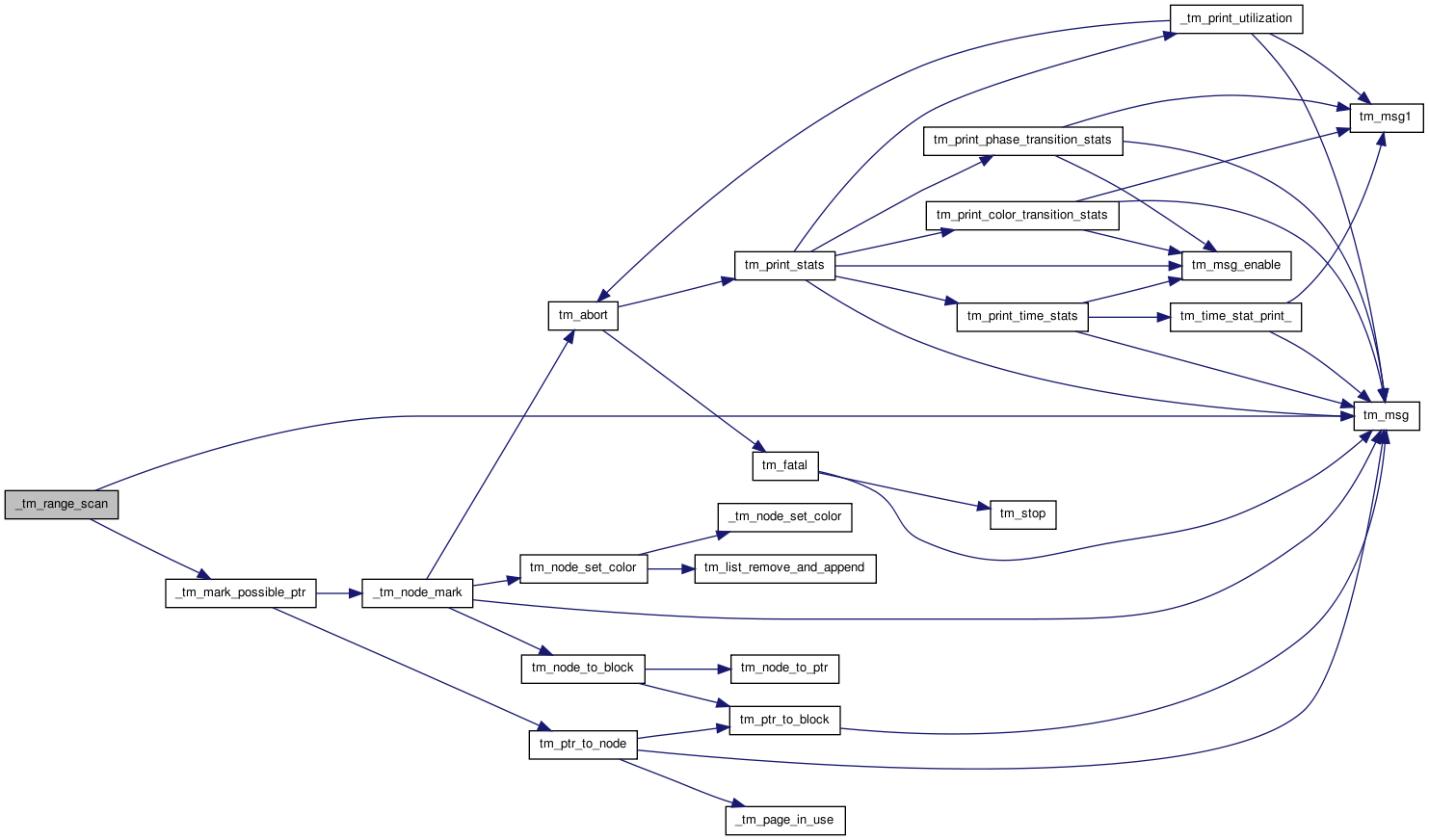

| void _tm_register_scan | ( | ) |
Scan registers.
Registers are in tm.root[0].
Definition at line 70 of file mark.c.
References _tm_root_scan_id().
Referenced by _tm_stack_scan().
00071 { 00072 _tm_root_scan_id(0); 00073 }
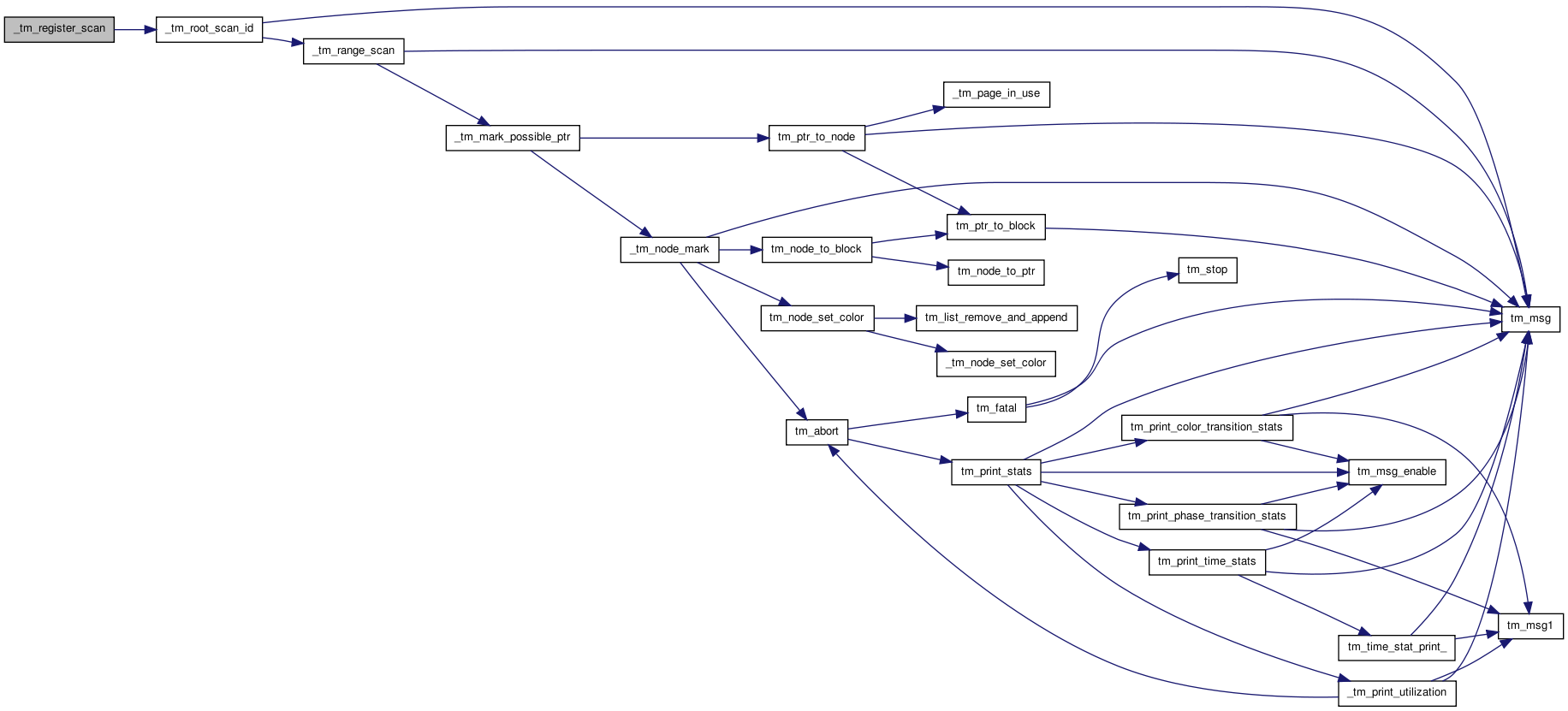

| void _tm_root_loop_init | ( | ) |
Initialize root scanning loop.
Definition at line 45 of file mark.c.
References tm_data::data_mutations, tm_root::l, tm_data::root_datai, tm_data::rooti, tm_data::roots, tm_data::rp, tm_data::stack_mutations, and tm.
Referenced by _tm_phase_init(), _tm_root_scan_all(), _tm_root_scan_some(), and tm_init().
00046 { 00047 tm.rooti = tm.root_datai; 00048 tm.rp = tm.roots[tm.rooti].l; 00049 tm.data_mutations = tm.stack_mutations = 0; 00050 }

| void _tm_root_scan_all | ( | ) |
Scan all roots.
Definition at line 102 of file mark.c.
References _tm_root_loop_init(), _tm_root_scan_id(), tm_data::data_mutations, tm_data::n, tm_root::name, tm_data::roots, tm_data::stack_mutations, tm, tm_BLACK, tm_GREY, and tm_msg().
Referenced by _tm_alloc_type_inner(), _tm_check_sweep_error(), and _tm_gc_full_type_inner().
00103 { 00104 int i; 00105 00106 tm_msg("r G%lu B%lu {\n", tm.n[tm_GREY], tm.n[tm_BLACK]); 00107 for ( i = 0; tm.roots[i].name; ++ i ) { 00108 _tm_root_scan_id(i); 00109 } 00110 tm.data_mutations = tm.stack_mutations = 0; 00111 _tm_root_loop_init(); 00112 #if 0 00113 tm_msg("r G%lu B%lu }\n", tm.n[tm_GREY], tm.n[tm_BLACK]); 00114 #endif 00115 }
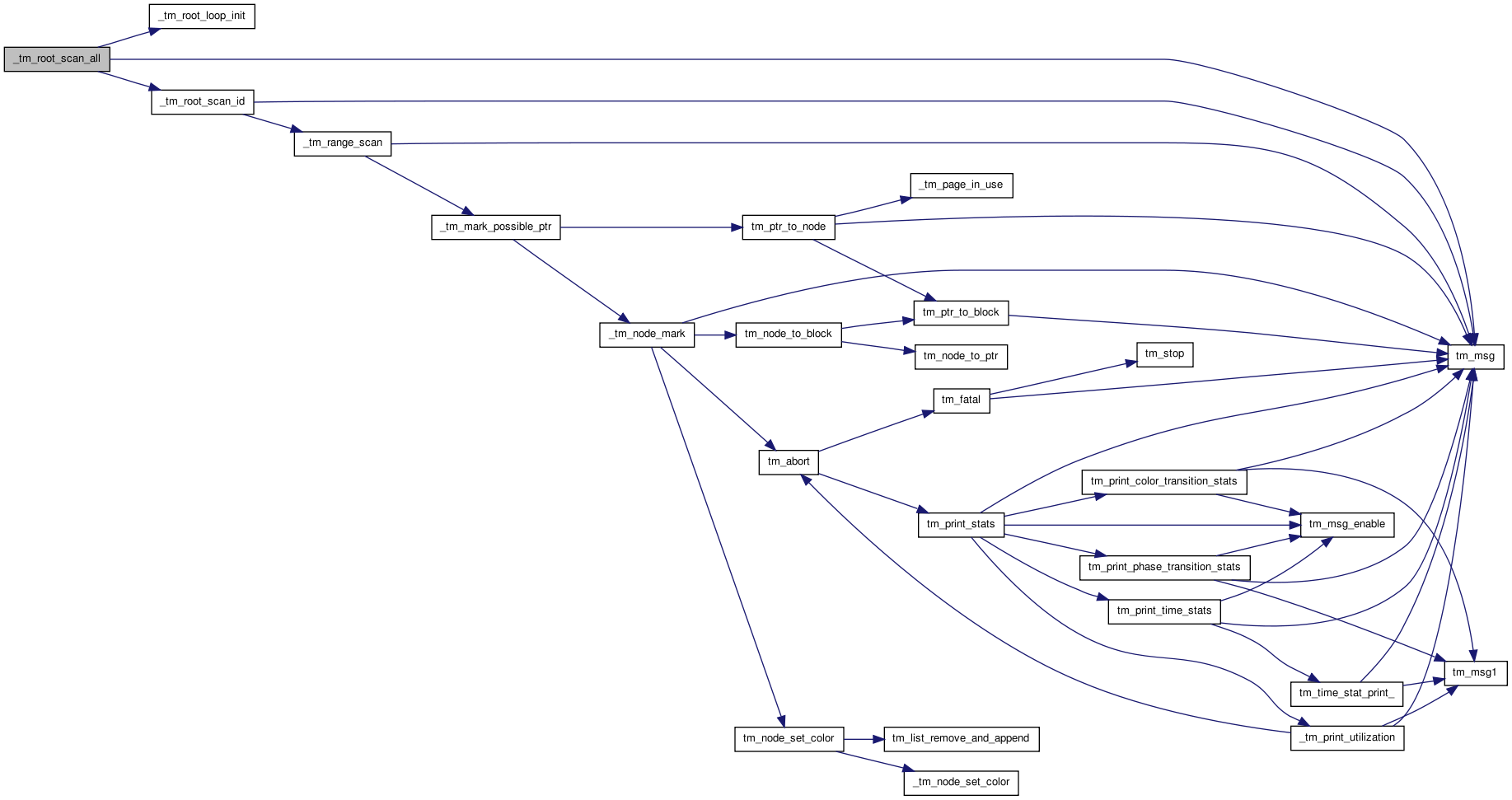

| static void _tm_root_scan_id | ( | int | i | ) | [static] |
Scan a root id.
Definition at line 57 of file mark.c.
References _tm_range_scan(), tm_root::h, tm_root::l, tm_root::name, tm_data::roots, tm, and tm_msg().
Referenced by _tm_register_scan(), _tm_root_scan_all(), and _tm_stack_scan().
00058 { 00059 if ( tm.roots[i].l < tm.roots[i].h ) { 00060 tm_msg("r [%p,%p] %s\n", tm.roots[i].l, tm.roots[i].h, tm.roots[i].name); 00061 _tm_range_scan(tm.roots[i].l, tm.roots[i].h); 00062 } 00063 }
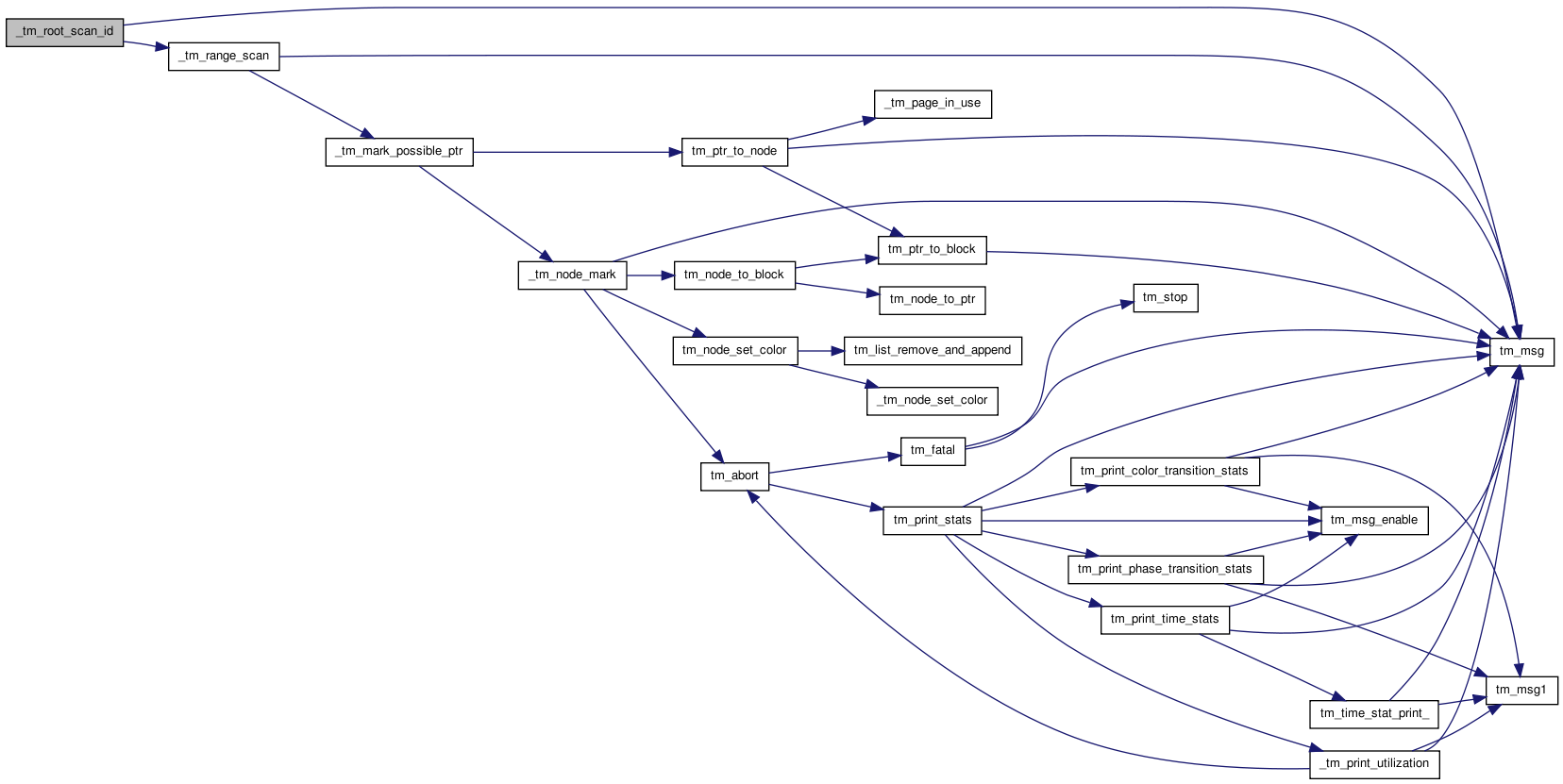

| int _tm_root_scan_some | ( | ) |
Scan some roots.
Definition at line 121 of file mark.c.
References _tm_mark_possible_ptr(), _tm_root_loop_init(), tm_root::h, tm_root::l, tm_data::n, tm_root::name, tm_data::rooti, tm_data::roots, tm_data::rp, tm, tm_BLACK, tm_GREY, tm_msg(), tm_PTR_ALIGN, and tm_root_scan_some_size.
Referenced by _tm_alloc_type_inner().
00122 { 00123 int result = 1; 00124 long left = tm_root_scan_some_size; 00125 00126 tm_msg("r G%lu B%lu {\n", tm.n[tm_GREY], tm.n[tm_BLACK]); 00127 tm_msg("r [%p,%p] %s\n", 00128 tm.roots[tm.rooti].l, 00129 tm.roots[tm.rooti].h, 00130 tm.roots[tm.rooti].name 00131 ); 00132 00133 do { 00134 /* Try marking some roots. */ 00135 while ( (void*) (tm.rp + sizeof(void*)) >= tm.roots[tm.rooti].h ) { 00136 ++ tm.rooti; 00137 if ( ! tm.roots[tm.rooti].name ) { 00138 _tm_root_loop_init(); 00139 tm_msg("r done\n"); 00140 00141 result = 0; 00142 goto done; 00143 } 00144 00145 tm_msg("r [%p,%p] %s\n", 00146 tm.roots[tm.rooti].l, 00147 tm.roots[tm.rooti].h, 00148 tm.roots[tm.rooti].name); 00149 00150 tm.rp = tm.roots[tm.rooti].l; 00151 } 00152 00153 _tm_mark_possible_ptr(* (void**) tm.rp); 00154 00155 tm.rp += tm_PTR_ALIGN; 00156 left -= tm_PTR_ALIGN; 00157 00158 } while ( left > 0 ); 00159 00160 done: 00161 #if 0 00162 tm_msg("r G%lu B%lu }\n", tm.n[tm_GREY], tm.n[tm_BLACK]); 00163 #endif 00164 00165 return result; /* We're not done. */ 00166 }
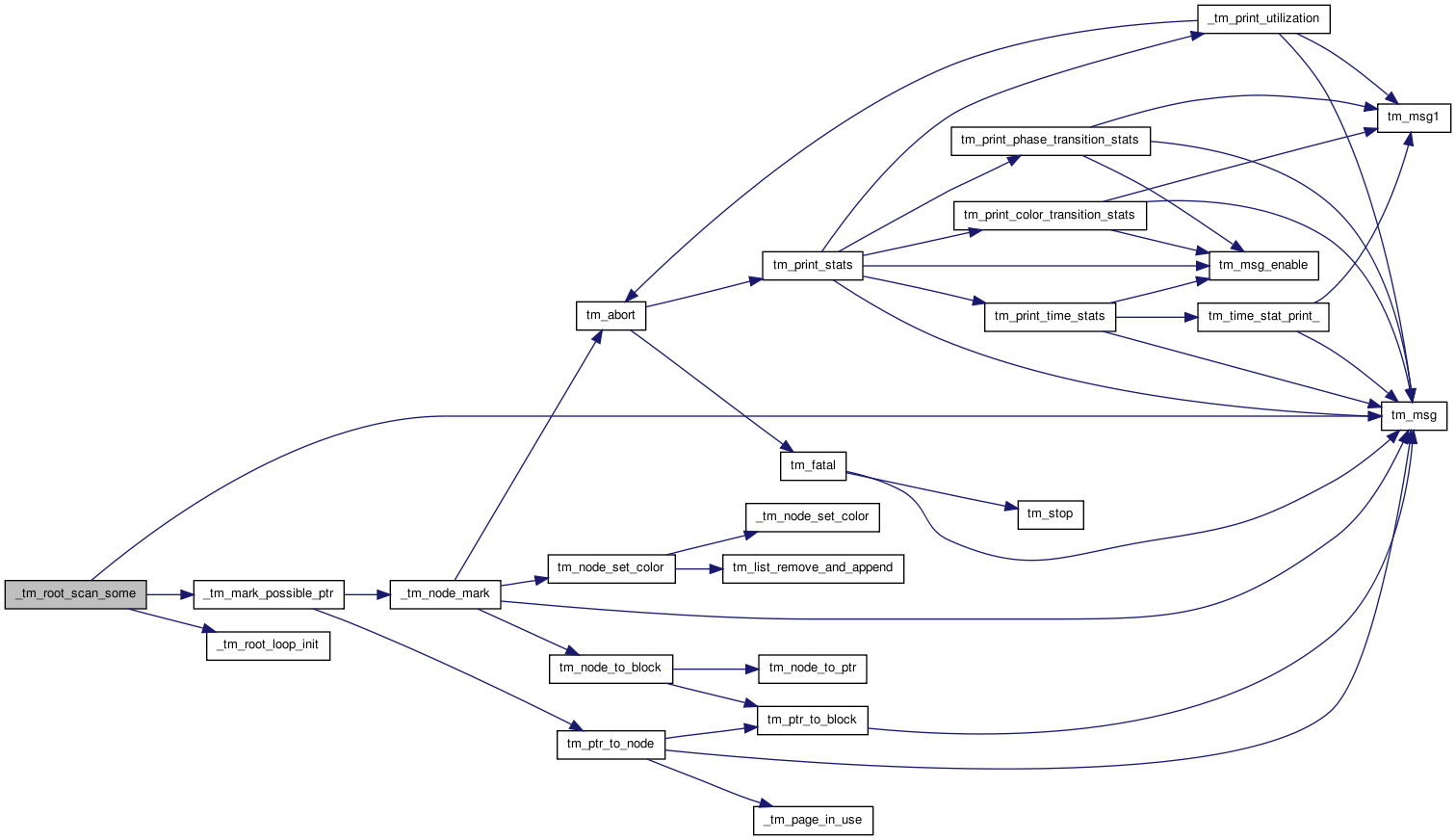

| void _tm_stack_scan | ( | ) |
Scan stack (and registers).
Mark stack as un-mutated.
Definition at line 91 of file mark.c.
References _tm_register_scan(), _tm_root_scan_id(), tm_data::stack_mutations, and tm.
00092 { 00093 _tm_register_scan(); 00094 _tm_root_scan_id(1); 00095 tm.stack_mutations = 0; 00096 }

Variable Documentation
| long tm_root_scan_some_size = 512 |
Amount of roots words to scan per tm_malloc().
Definition at line 40 of file mark.c.
Referenced by _tm_root_scan_some().
 1.6.1
1.6.1